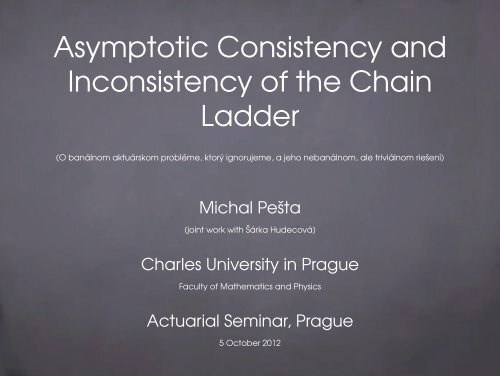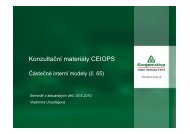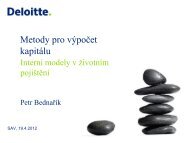Asymptotic Consistency and Inconsistency of the Chain Ladder
Asymptotic Consistency and Inconsistency of the Chain Ladder
Asymptotic Consistency and Inconsistency of the Chain Ladder
You also want an ePaper? Increase the reach of your titles
YUMPU automatically turns print PDFs into web optimized ePapers that Google loves.
<strong>Asymptotic</strong> <strong>Consistency</strong> <strong>and</strong><strong>Inconsistency</strong> <strong>of</strong> <strong>the</strong> <strong>Chain</strong><strong>Ladder</strong>(O banálnom aktuárskom probléme, ktorý ignorujeme, a jeho nebanálnom, ale triviálnom riešení)Michal Pešta(joint work with Šárka Hudecová)Charles University in PragueFaculty <strong>of</strong> Ma<strong>the</strong>matics <strong>and</strong> PhysicsActuarial Seminar, Prague5 October 2012
Overview- Claims reserving in non-life insurance- <strong>Chain</strong> ladder model- Open problem: consistency <strong>of</strong> <strong>the</strong> developmentfactors- Simulations <strong>and</strong> real data example• Based on:Pešta <strong>and</strong> Hudecová (2012). <strong>Asymptotic</strong> consistency<strong>and</strong> inconsistency <strong>of</strong> <strong>the</strong> chain ladder. Insurance:Ma<strong>the</strong>matics <strong>and</strong> Economics, 51(2): 472 – 479.• Support:Czech Science Foundation project “DYME DynamicModels in Economics” No. P402/12/G097
Non-life insurance- Operates on <strong>the</strong> lines <strong>of</strong> business (LoB):◮ motor/car insurance (motor third party liability,motor hull)◮ property insurance (private <strong>and</strong> commercialinsurance against fire, water, flooding, businessinterruption, . . . )◮ liability insurance◮ accident insurance◮ health insurance◮ marine insurance (including transportation)◮ o<strong>the</strong>r (aviation, travel insurance, legal protection,credit insurance, epidemic insurance, . . . )- Life insurance products are ra<strong>the</strong>r different, e.g.,terms <strong>of</strong> contracts, type <strong>of</strong> claims, risk drivers
Timeline <strong>of</strong> a claimAccident dateClaim closingClaim closingReporting dateReopeningClaim paymentsPayments✞✝❄☎✆❄❄❄❄❄❄ ❄❄❄✲Insurance periodTime
Settlement <strong>of</strong> a claim- Reporting delay (between occurrence <strong>and</strong>reporting) – can take several years (liabilityinsurance: asbestos or environmental pollutionclaims)- After being reported to <strong>the</strong> insurer – severalyears may elapse before <strong>the</strong> claim is finally settled(fast in property insurance, liability or bodily injuryclaims: long time before <strong>the</strong> total circumstancesare clear <strong>and</strong> known)- Reopening – (unexpected) new developments, or ifa relapse occurs
Reserving- Claims reserves represent <strong>the</strong> money which shouldbe held by <strong>the</strong> insurer so as to be able to meet allfuture claims arising from policies currently inforce <strong>and</strong> policies written in <strong>the</strong> past- Most non-life insurance contracts are writtenfor a period <strong>of</strong> one year- Only one payment <strong>of</strong> premium at <strong>the</strong> start <strong>of</strong> <strong>the</strong>contract in exchange for coverage over <strong>the</strong> year- Reserves are calculated byforecasting future losses from past losses
Terminology- X i,j . . . claim amounts in development year j withaccident year i- X i,j st<strong>and</strong>s for <strong>the</strong> incremental claims in accidentyear i made in accounting year i + j- n . . . current year – corresponds to <strong>the</strong> mostrecent accident year <strong>and</strong> development period- Our data history consists <strong>of</strong>right-angled isosceles triangles X i,j , wherei = 1, . . . , n <strong>and</strong> j = 1, . . . , n + 1 − i
Notation- C i,j . . . cumulative payments in origin year i after jdevelopment periodsC i,j =j∑k=1X i,k- C i,j . . . a r<strong>and</strong>om variable <strong>of</strong> which we have anobservation if i + j ≤ n + 1- Aim is to estimate <strong>the</strong> ultimate claims amount C i,n<strong>and</strong> <strong>the</strong> outst<strong>and</strong>ing claims reserveR i = C i,n − C i,n+1−i ,i = 2, . . . , n
Run-<strong>of</strong>f triangleAccidentDevelopment year jyear i 1 2 · · · n − 1 n1 C 1,1 C 1,2 · · · C 1,n−1 C 1,n2 C 2,1 C 2,2 · · · C 2,n−1. ..... C i,n+1−in − 1 C n−1,1 C n−1,2n C n,1
Reasonable Estimatefor Reserves- nonsense estimate, e.g., ̂Ri = 10 6 or ̂R i = −1◮ why bad? <strong>the</strong> most precise estimate (in terms <strong>of</strong>variability) Var ̂R i = 0- unbiased estimate, i.e., E ̂R i = ER i , or conditionallyunbiased◮ firstly, introduce a model with assumptions, <strong>the</strong>nconstruct an estimate◮ have you ever heard <strong>of</strong> a reserving model withunbiased estimates <strong>of</strong> reserves?- consistent estimate (but where’s n ?)̂R i(stochastically)−−−−−−−−−→ R in→∞
<strong>Chain</strong> ladderMack (1993)[1] E[C i,j+1 |C i,1 , . . . , C i,j ] = f j C i,j[2] Var[C i,j+1 |C i,1 , . . . , C i,j ] = σ 2 j C i,j[3] Accident years [C i,1 , . . . , C i,n ] are independentvectors
Development factors f j∑ n−ĵf (n)j=i=1 C i,j+1∑ n−ji=1 C , 1 ≤ j ≤ n − 1i,ĵf (n)n ≡ 1 (assuming no tail)
Properties- Ultimate claims amounts C i,n are estimated byĈ i,n = C i,n+1−i ×(n)(n)̂fn+1−i× · · · × ̂f n−1- Under <strong>the</strong> assumptions [1], [3], <strong>and</strong>∑ n−j[4]i=1 C i,j > 0̂f (n)jare unbiased <strong>and</strong> mutually uncorrelated- Assumption [2] is essential for <strong>the</strong> st<strong>and</strong>ard error<strong>of</strong> Ĉi,n
Unbiasedness- unbiasedness <strong>of</strong> development factors unbiasedness <strong>of</strong> reserves’ estimate !- given data D j = {C i,k : k ≤ j, i ∈ N} or {C i,1 , . . . , C i,j },where j = n + 1 − iE [R i |D n+1−i ] = E [C i,n − C i,n+1−i |D n+1−i ]= E [C i,n |D n+1−i ] − C i,n+1−i= E [E {C i,n |C i,1 , . . . , C i,n−1 } |D n+1−i ] − C i,n+1−i= E [f n−1 C i,n−1 |D n+1−i ] − C i,n+1−i = . . .= f n−1 . . . f n+2−i E [f n+1−i C i,n+1−i |D n+1−i ] − C i,n+1−i= C i,n+1−i (f n+1−i × . . . × f n−1 − 1) , a.s.
(Un)biasedness- ̂R( )i = Ĉi,n(n)(n)− C i,n+1−i = C i,n+1−i ̂fn+1−i× · · · × ̂f n−1 − 1[ ] ( [ ] )(n)(n)E ̂Ri |D n+1−i = C i,n+1−i E ̂fn+1−i× · · · × ̂f n−1 |D n+1−i − 1= . . . = E [R i |D n+1−i ] , a.s.- how much is unbiasedness important? <strong>and</strong> can wealways achieve it? do we need to?
(In)consistency- disadvantage:◮ asymptotic property (data history sufficiently long)◮ only a qualitative property- advantages:◮ easier to verify (?)◮ characterize <strong>the</strong> accuracy (<strong>and</strong>, hence,meaningfulness) <strong>of</strong> an estimate◮ can be quantified (e.g., rate <strong>of</strong> consistency)◮ is retained by algebraic operations
Open problem- From some point <strong>of</strong> view, consistency is moreimportant than unbiasedness(n)(n)- E.g., ̂fn+1−i× · · · × ̂fmethod usesn−1- The unbiasedness <strong>of</strong>̂β (n)jin any senseor Bornhuetter-Ferguson̂β (n)n−1∏j=̂f(n)jk=j- Ex: Y 1 , . . . , Y n iid with finite EY1̂f (n)kdoes not “transfer” to- T 1 (Y 1 , . . . , Y n ) = Y 1 vs T 2 (Y 1 , . . . , Y n ) = 1 n∑ ni=1 Y i + 1 n
StochasticConvergence- deterministic: one convergence (<strong>of</strong> real numbers)- almost sureP- in probability- L p , p ≥ 1-X n[ω ∈ Ω :∀ε > 0 :(stochastically)−−−−−−−−−→ Xn→∞]lim X n(ω) = X(ω) = 1n→∞lim P [|X n − X| ≥ ε] = 0n→∞lim E|X n − X| p = 0n→∞a.s.−−−→ ⇒ P−−−→ ⇐ −−−→Lp;n→∞ n→∞ n→∞P−−−→⇒ −−−→Dn→∞ n→∞
Conditionalconvergenceξ nξ n[P ζ ]-a.s.−−−−−→ χ, [P]-a.s. meansn→∞{} ]P[P ζ lim ξ n = χ = 1 = 1n→∞P ζn−−−→ χ, [P]-a.s. meansn→∞[]∀ε > 0 : P lim P ζn→∞ n{|ξ n − χ| ≥ ε} = 0 = 1L p(P ζn )ξ n −−−−−→ χ, [P]-a.s. (p ≥ 1) meansn→∞[]P lim E ζn→∞ n|ξ n − χ| p = 0 = 1
Conditioning- Conditional convergence in probability <strong>and</strong> in L palong some sequence <strong>of</strong> r<strong>and</strong>om variables {ζ n } ∞ n=1can be defined, because <strong>the</strong> concept <strong>of</strong> <strong>the</strong>se twotypes <strong>of</strong> convergence comes from a topology- Despite <strong>of</strong> that, <strong>the</strong> almost sure convergence doesnot correspond to a convergence with respect toany topology <strong>and</strong>, hence, it is not metrizable- Thereafter, <strong>the</strong> conditional convergencealmost surely cannot be defined along a sequence<strong>of</strong> r<strong>and</strong>om variables, but only given one r<strong>and</strong>omvariable ζ
<strong>Consistency</strong>Denote D (n)j= {C i,k : k ≤ j, i ≤ n − j + 1} <strong>and</strong>D j = {C i,k : k ≤ j, i ∈ N}. Then (i)–(iv) are equivalent:(i)̂f (n) [P Dj ]-a.s.j−−−−−−→ f j, [P]-a.s.;n→∞(ii)(iii)(iv)̂f (n)jn−j∑i=1̂f (n)jP D(n)j−−−→n→∞ f j, [P]-a.s.;L 2(P (n) Dj)−−−−−−−→ f j, [P]-a.s.;n→∞C i,j −−−→n→∞∞, [P]-a.s.
Remark IDue to <strong>the</strong> independence <strong>of</strong> <strong>the</strong> different accidentyears (assumption [3]), <strong>the</strong> statements (ii) <strong>and</strong> (iii) canbe equivalently replaced bŷf (n)jP Dj−−−→ f j, [P]-a.s.n→∞<strong>and</strong>respectively.̂f (n)jL 2 (P Dj )−−−−−→ f j, [P]-a.s.,n→∞
Remark II- Unconditional consistency in case <strong>of</strong> <strong>the</strong> L 2convergence-̂f(n)j→ f j in L 2 (unconditionally) as n → ∞ iff[ ]1E ∑ n−ji=1 C → 0,i,jn → ∞- This condition is obviously more complicated than<strong>the</strong> condition (iv), <strong>and</strong> it is practically unverifiable- Thus, <strong>the</strong> conditional convergence is not onlymore natural one in this case, but even moreconvenient one
Rate <strong>of</strong> convergence- <strong>Consistency</strong> <strong>of</strong> an estimator is a very importantbut only qualitative property- Measure consistency – quantitative way- Denote <strong>the</strong> conditional mean square error <strong>of</strong> <strong>the</strong>estimate <strong>of</strong> development factor f j asMSE( ) { [(n)(n)̂fj:= E ̂fj− E(̂f(n)j)] 2 ∣ ∣∣D (n)j}.Then, with probability one holds⎛[ ( )n−j] −1⎞(n)MSE ̂fj= O ⎝ C i,j⎠ , n → ∞.∑i=1
On <strong>the</strong> rate <strong>of</strong>convergence- Complete characterization <strong>of</strong> <strong>the</strong> conditionalconvergence <strong>of</strong> development factors’ estimate- The slower (faster) divergence <strong>of</strong>∞∑i=1C i,jimplies <strong>the</strong> slower (faster) realization <strong>of</strong>consistency <strong>of</strong> <strong>the</strong> development factors’ estimates
On <strong>the</strong> necessary <strong>and</strong>sufficient conditionLet j ∈ N be fixed. Then <strong>the</strong> following conditions areequivalent.2.1. The condition (iv) holds.∞∑EC i,1 = ∞. (1)i=13. The condition (iv) holds for j 0 ∈ N, j ≠ j 0 .
Practical aspectŝf(n)- Ei<strong>the</strong>rjis consistent for f j for all j ∈ N, ornone <strong>of</strong> <strong>the</strong>m is consistent̂f(n)j- The consistency <strong>of</strong> is equivalent to <strong>the</strong>condition ∑ ni=1 C i,1 → ∞, [P]-a.s. as n → ∞- Denote S k = ∑ ki=1 C i,1, k = 1, . . . , n <strong>the</strong> cumulativesums <strong>of</strong> <strong>the</strong> cumulative claims C i,1 in <strong>the</strong>first development year- For instance, <strong>the</strong> ratios C k+1,1 /C k,1 or <strong>the</strong>sequence k√ C k,1 can be studied- Artificial data set Taylor <strong>and</strong> Ashe (1983)
Real data exampleS k500000 2000000 3500000●●●●●●●●●●2 4 6 8 10k
<strong>Inconsistency</strong>- What kinds <strong>of</strong> business behavior corresponds to<strong>the</strong> violation <strong>of</strong> consistency?- For instance, condition (iv) can be violated if oneobserves a decreasing trend (decreasing fastenough) in payments across <strong>the</strong> accident years- So to speak, <strong>the</strong> corresponding line <strong>of</strong> business isworsening maybe due to new insurance companiesentering <strong>the</strong> market or changing (decreasing)prices <strong>of</strong> such insurance product- Fur<strong>the</strong>rmore, splitting one existing line <strong>of</strong>business into several o<strong>the</strong>rs can also causeinconsistency in <strong>the</strong> estimation <strong>of</strong> developmentfactors
Simulations- C i,1 was generated such that C i,1 ∈ L 2 <strong>and</strong> C i,j ≥ 0- f j was set to f j = j/(j + 1)- C i,2 , . . . C i,N were generated successively such thatC i,j satisfies [1] <strong>and</strong> [2]- Hence, for each j, C i,j is drawn from a distributionwith mean f j−1 C i,j−1 <strong>and</strong> variance σj 2C i,j−1 for someσj 2 ∈ (0, ∞)- Since <strong>the</strong> accident years are assumed to beindependent (assumption [3]), <strong>the</strong> rows <strong>of</strong> <strong>the</strong> datasets were generated separately, using <strong>the</strong> sameapproach- C i,1 were drawn from <strong>the</strong> exponential distribution,<strong>and</strong> <strong>the</strong> C i,j was generated from <strong>the</strong>Poisson distribution with <strong>the</strong> parameter f j−1 C i,j−1for j = 2, . . . , N
Decreasing business- consider a fast decreasing business, i.e., <strong>the</strong>situation where condition (1) does not hold- C i,1 was generated from <strong>the</strong> exponentialdistribution with <strong>the</strong> mean i −2 × 10 6-̂f(n)jdo not converge to <strong>the</strong> true value f j- Their values are close to f j in this setting, but <strong>the</strong>estimates are indeed not consistent- The same simulations were run also for C i,1 with<strong>the</strong> uniform distribution: <strong>the</strong> differences between(n)values <strong>of</strong> estimates ̂fj<strong>and</strong> <strong>the</strong> true values f j aremore noticeable
Example Ij = 1j = 2f j0.498 0.499 0.500 0.501 0.502●^(n) ^(n)● ● ● ● ● ● ● ● ● ● ● ● ● ● ● ● ● ● ● ●● ● ● ● ● ● ● ● ● ● ● ● ● ● ● ● ● ● ● ● ●f j10 20 30 40 5010 20 30 40 50nn0.665 0.666 0.667 0.668j = 3j = 40.748 0.749 0.750 0.751 0.752^(n)f jf j● ● ● ● ● ● ● ● ● ● ● ● ● ● ● ● ● ● ● ● ●● ● ● ●● ● ● ● ● ● ● ● ● ● ● ● ● ● ● ● ●10 20 30 40 50n0.798 0.799 0.800 0.801 0.802^(n)10 20 30 40 50n
Slowly decreasingbusiness- situation where EC i,1 decreases with increasing i,but in a slow manner such that condition (1) holds- EC i,1 = i −1/2 × 10 6 in <strong>the</strong> exponential distribution- clear convergence pattern can be observed,(n)confirming that <strong>the</strong> estimates ̂fjare consistentin this case
Example IIj = 1j = 20.498 0.499 0.500 0.501 0.502^(n) ● ●● ● ● ● ● ● ● ● ● ● ●● ● ● ● ●● ● ● ● ● ● ●f j● ● ●● ● ● ● ● ● ● ● ● ● ● ● ● ●10 20 30 40 5010 20 30 40 50nn0.665 0.666 0.667 0.668^(n)f jj = 3j = 40.748 0.749 0.750 0.751 0.752●● ● ● ●●● ● ● ● ● ● ●^(n) ●● ●● ● ●●●f ^(n)● ●j● ● ●f j●● ● ● ● ● ● ●● ● ● ● ●●● ●10 20 30 40 50n0.798 0.799 0.800 0.801 0.80210 20 30 40 50n
Growing business- EC i,1 increases with increasing i- The parameters <strong>of</strong> <strong>the</strong> exponential distributionwere set such that EC i,1 = √ i × 10 6- The figure obviously confirms that <strong>the</strong> estimatesare consistent(n)- Moreover, ̂fjconverges to <strong>the</strong> true values f jmuch faster than in previous case
Example IIIj = 1j = 20.498 0.499 0.500 0.501 0.502^(n) ● ● ● ● ● ● ● ● ● ● ● ● ● ● ● ● ● ●f j● ●f ● ● ● ●●j^(n)● ● ● ● ● ● ● ● ● ● ● ● ● ● ● ● ●10 20 30 40 5010 20 30 40 50nn0.665 0.666 0.667 0.668j = 3j = 40.748 0.749 0.750 0.751 0.752^(n) ●● ● ● ● ● ● ● ● ● ● ● ● ● ● ● ● ● ● ●●f ● ● ● ●j● ● ● ● ● ● ● ●●f j●● ●10 20 30 40 50n0.798 0.799 0.800 0.801 0.802^(n)● ● ● ● ●10 20 30 40 50n
One Year Prospective- in <strong>the</strong> classical claims reserving, one usually studies<strong>the</strong> total uncertainty in <strong>the</strong> claims developmentuntil <strong>the</strong> total ultimate claim is finally settled- Solvency II purposes- run-<strong>of</strong>f = opening balance – expenses – closingbalance- we predict <strong>the</strong> total ultimate claim at time n (with<strong>the</strong> available information up to time n), <strong>and</strong> oneperiod later at time n + 1 we predict <strong>the</strong> same totalultimate claim with <strong>the</strong> updated informationavailable at time n + 1- difference between <strong>the</strong>se two successivepredictions is <strong>the</strong> claims development result (CDR)for accounting year (n, n + 1]
CDR- a direct impact on <strong>the</strong> P&L statement <strong>and</strong> on <strong>the</strong>financial strength <strong>of</strong> <strong>the</strong> insurance company- CDR for accident year i <strong>and</strong> accounting year(n, n + 1]CDR i (n + 1) = E[C i,n |D (n) ] − E[C i,n |D n+1 ]where= E[R (n)i|D (n) ] − (X i,n+2−i + E[R n+1i|D n+1 ])D (n) = {C i,j : i + j ≤ n + 1}D n+1 = {C i,j : i + j ≤ n + 2 & i ≤ n + 1}R (n)iRin+1= D (n) ∪ {C i,n+2−i : i ≤ n + 1}= C i,n − C i,n+1−i= C i,n − C i,n+2−i
Merz-Wüthrich(1i)- implied <strong>Chain</strong> <strong>Ladder</strong> assumptions (time series):C i,j = f j−1 C i,j−1 + σ j−1√Ci,j−1 ε i,j ,where ε i,j are iid with Eε i,j = 0 <strong>and</strong> Varε i,j = 1(2i) Accident years [C i,1 , . . . , C i,n ] are independentvectors
Reasonable results?- using <strong>the</strong> martingale propertyE[CDR i (n + 1)|D (n) ] = 0- prediction uncertainty in <strong>the</strong> budget value 0 for<strong>the</strong> observable claims development result at <strong>the</strong>end <strong>of</strong> <strong>the</strong> accounting periodMSEĈDRi(n+1)|D (n) (0) = E[(ĈDR i (n + 1) − 0) 2 |D (n) ]- in <strong>the</strong> solvency margin, we need to hold risk capitalfor possible negative deviations <strong>of</strong> CDR i (n + 1)from 0? are <strong>the</strong> “results” by MW reasonable (e.g.,consistent estimate <strong>of</strong> MSEĈDRi(n+1)|D (n) (0))?
Conclusions- conditional consistency <strong>and</strong> inconsistency <strong>of</strong> <strong>the</strong>development factors’ estimate in <strong>the</strong>distribution-free chain ladder is investigated- necessary <strong>and</strong> sufficient condition is derived- weak, strong consistency, <strong>and</strong> consistency in <strong>the</strong>mean square are equivalent- convergence rate is provided- practical recommendations, how to check thisnecessary <strong>and</strong> sufficient condition, are discussed- real data example <strong>and</strong> numerical simulations toillustrate <strong>the</strong> performance <strong>of</strong> <strong>the</strong> estimates- possible violation <strong>of</strong> <strong>the</strong> condition with <strong>the</strong>consequences is demonstrated
ReferencesMack, T. (1993)Distribution-free calculation <strong>of</strong> <strong>the</strong> st<strong>and</strong>ard error<strong>of</strong> chain ladder reserve estimates.Astin Bulletin, 23(2), 213–225.Merz, M. <strong>and</strong> Wuthrich, M. V. (2008)Modeling <strong>the</strong> claims development results forSolvency purposes.CAS E-Forum, Fall 2008, 542–568.Pesta, M. <strong>and</strong> Hudecova, S. (2012)<strong>Asymptotic</strong> consistency <strong>and</strong> inconsistency <strong>of</strong> <strong>the</strong>chain ladder.Insurance: Ma<strong>the</strong>matics <strong>and</strong> Economics, 51(2),472–479.
Thank you !pesta@karlin.mff.cuni.cz






